Add this eBook to your basket to receive access to all 275 records. Our indexes include entries for the spelling western. In the period you have requested, we have the following 275 records (displaying 221 to 230): These sample scans are from the original record. You will get scans of the full pages or articles where the surname you searched for has been found. Your web browser may prevent the sample windows from opening; in this case please change your browser settings to allow pop-up windows from this site. Residents of Surrey
(1895)
Kelly's Directory of Surrey includes this alphabetical Court Directory, listing private residents in the county. In fact, this listing is a little more comprehensive than the main directory, in that it includes residents of some London suburbs that, although in the county of Surrey, are not included in the Surrey directory. Residents are listed surname first, then christian name or initials, and postal address. | Sample scan, click to enlarge

| Boys entering Marlborough College
(1896)
The public school at Marlborough in Wiltshire was founded in 1843. In 1952 this, 9th, edition of the college register was published, being a revision by L. Warwick James of the 8th edition (of 1936): but for the years before 1936 it does not merely repeat the 8th edition, because Warwick James was able to correct the 19th-century entries with information from newly-discovered letters and books from 1843 to 1853, and the school lists from 1844 onwards. The roll is arranged by year, and within each year by term of entrance, and then alphabetically by surname within each term. Each boy is assigned a number within the year: then his name is given, surname first, and, in brackets, his house. The houses within the college were called B1, B2, B3, C1, C2 and C3, and the Lower School (L Sch); the out college houses were Preshute, Priory, Cotton, Hermitage, Littlefield, Barton Hill, Summerfield and Upcot. Then there is given the boy's father's name (surname and initials) and address (at entrance), the boy's date of birth (b) and month of leaving (l). Where the boy represented the school at Rugby football (XV) or cricket (XI), in the rifle corps (VIII, or RC XI), that is indicated. There is a brief summary of achievements in later life, and, where known, and date of death or (in italics) address as in 1952. | Sample scan, click to enlarge
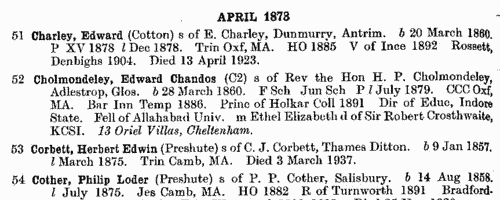
| Boys entering Haileybury College, Hertfordshire
(1901)
Haileybury College, near Hertford, was founded by the East India Company in 1806, and incorporated by Royal Charter in 1864. This register of pupils entering the school from 1862 to 1931 was edited by a master there, Laurence Arthur Speakman. The boys are listed by term of joining the school, and then alphabetically by name (in bold), surname first (in capitals). There is then usually a precise birthdate, and the name and address of his father; his period at the school, starting with abbreviations to indicate the house to which he belonged (B., Batten; B. F., Bartle Frere; C., Colvin; E., Edmonstone; Ha., Hailey; Hi., Highfield; L., Lawrence; Le B., Le Bas; M., Melvill; Th., Thomason; T., Trevelyan), and the first and last forms attended (e. g., IV., fourth form). Where a member of a school team there is then an indication (e. g., XI., cricket). For some pupils, with whom the school had lost touch, Speakman was only able to record the details of their time at Haileybury; but for most a brief career synopsis is then given, and current address (as in 1931) or date of death.
| Sample scan, click to enlarge
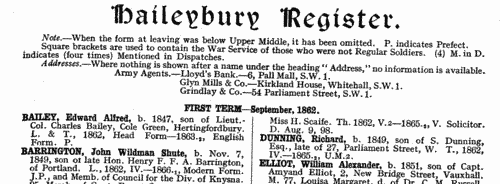
|  British artillerymen fighting in South Africa
(1899-1902) British artillerymen fighting in South Africa
(1899-1902)
The Queen Victoria's South Africa Medal was awarded (after her death, in the event) to all who had served honourably in the various campaigns in the Boer War. Returns were made from each unit, and consolidated into nominal roll, of which this is the one for the Royal Artillery. Confusingly, the ledgers used had originally been printed for a register of men transferred (or re-transferred after mobilization) to 1st Class Army Reserve. All the original column headings were therefore struck through, and the roll was prepared with this information: Date of Issue; Regimental Number; Rank; Name; Unit; Medal (a 1 indicating that a medal was awarded); [number of] Clasps; the reference to the source in the original returns, usually starting with AG for papers in the hands of the Adjutant-General, and 68/Art/ for the Royal Artillery records. The final column, normally left blank, was occasionally used for explanatory remarks. | Sample scan, click to enlarge

| Associate Members of the Institution of Civil Engineers
(1904)
The Institution of Civil Engineers was established 2 January 1818, and incorporated by royal charter 3 June 1828. The annual report lists the names and addresses (throughout the world) of the four classes of member - members (M. Inst. C. E.), associate members (Assoc. M. Inst. C. E.), associates (Assoc. Inst. C. E.), students (Stud. Inst. C. E.) - with the dates of admission. This is the index to the Associate Members. The symbols at the left of each page are * for Former Students, + for contributors of papers published in the Minutes of Proceedings, or of an Engineering Conference Note; F for a deliverer of a James Forrest Lecture; L for a deliverer of one of the Special Series of Lectures; and various letters for recipients of certain medals and prizes - B, Bayliss Prize; C, Crampton Prize; f, James Forrest Medal; H, Howard Quinquennial Prize; J, Joule Medal; M, Miller Scholarship; m, Miller Prize; italic m, Manby Premium; S, George Stephenson Medal or Prize; T, Telford Premium; t, Telford Premium; italic t, Trevithick Premium; and W, Watt Medal. Those elected prior to 2 December 1878 had been transferred into this class by the Council. | Sample scan, click to enlarge
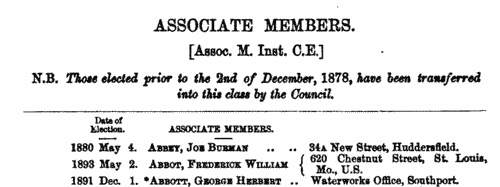
| Associates of the Institution of Civil Engineers
(1904)
The Institution of Civil Engineers was established 2 January 1818, and incorporated by royal charter 3 June 1828. The annual report lists the names and addresses (throughout the world) of the four classes of member - members (M. Inst. C. E.), associate members (Assoc. M. Inst. C. E.), associates (Assoc. Inst. C. E.), students (Stud. Inst. C. E.) - with the dates of admission. This is the index to the Associates. The symbols at the left of each page are * for Former Students, + for contributors of papers published in the Minutes of Proceedings, or of an Engineering Conference Note; F for a deliverer of a James Forrest Lecture; L for a deliverer of one of the Special Series of Lectures; and various letters for recipients of certain medals and prizes - B, Bayliss Prize; C, Crampton Prize; f, James Forrest Medal; H, Howard Quinquennial Prize; J, Joule Medal; M, Miller Scholarship; m, Miller Prize; italic m, Manby Premium; S, George Stephenson Medal or Prize; T, Telford Premium; t, Telford Premium; italic t, Trevithick Premium; and W, Watt Medal. Those elected prior to 2 December 1878 had been transferred into this class by the Council. | Sample scan, click to enlarge
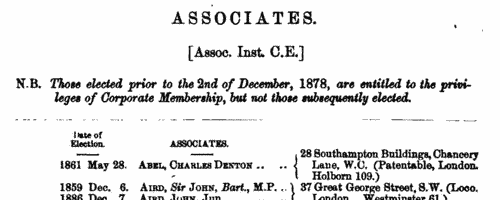
| Indian Civil Servants
(1904)
The India List and India Office List was compiled from official records by direction of the Secretary of State for India in Council, and published by the India Office annually. The volume for 1905 includes this Record of Services, corrected to 1 July 1904. It includes Officers of the Home Establishment of the Secretary of State, Officers of the Covenanted Civil Service, and those appointed under the Native Civil Service Rules, other Officers in Civil Employment in India whose substantive pay was at least 1000 rupees a month, and, with a few exceptions, all officers of those classes who had retired since 1886. | Sample scan, click to enlarge

| Members of the Institution of Civil Engineers
(1904)
The Institution of Civil Engineers was established 2 January 1818, and incorporated by royal charter 3 June 1828. The annual report lists the names and addresses (throughout the world) of the four classes of member - members (M. Inst. C. E.), associate members (Assoc. M. Inst. C. E.), associates (Assoc. Inst. C. E.), students (Stud. Inst. C. E.) - with the dates of admission. This is the index to the Members, which also gives dates of transfer from other grades. The symbols at the left of each page are * for Former Students, + for contributors of papers published in the Minutes of Proceedings, or of an Engineering Conference Note; F for a deliverer of a James Forrest Lecture; L for a deliverer of one of the Special Series of Lectures; and various letters for recipients of certain medals and prizes - B, Bayliss Prize; C, Crampton Prize; f, James Forrest Medal; H, Howard Quinquennial Prize; J, Joule Medal; M, Miller Scholarship; m, Miller Prize; italic m, Manby Premium; S, George Stephenson Medal or Prize; T, Telford Premium; t, Telford Premium; italic t, Trevithick Premium; and W, Watt Medal. | Sample scan, click to enlarge
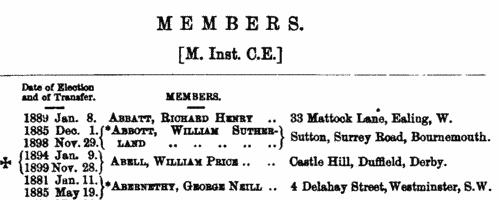
|  Queen's South Africa Medal: Royal Field Artillery: 38th Battery
(1901-1905) Queen's South Africa Medal: Royal Field Artillery: 38th Battery
(1901-1905)
The nominal roll for the Queen Victoria's South Africa Medal - awarded (after her death, in the event) to all who had served honourably in the various campaigns in the Boer War - was compiled from these returns from the individual units. Two sets of form were completed. The main one, as in the sample scan, dates from 1901 and gives regimental number, rank, and full name (surname first), followed by a series of columns relating to different actions - Belmont, Modder River, Paardeberg, Dreifontein, Wepener, Johannesburg, Diamond Hill, Belfast, Wittebergen, Defence of Kimberley, Relief of Kimberley, Defence of Mafeking, Relief of Mafeking, Cape Colony, Orange Free State, Transvaal, Rhodesia, Talana, Elandslaagte, Tugela Heights, Defence of Ladysmith, Relief of Ladysmith, Laing's Nek, and Natal; each entitled the man to a separate clasp to the medal, and a tick or a Yes in the appropriate column indicates the man's actual physical presence in that battle. A final column for remarks is important in those cases where the man was no longer in the unit, by removal, death or desertion. The second form that sometimes occurs was returned in 1905, and covers men entitled to the Second South African War Medal and Clasps. It lists men by number, rank and name, checks whether they had claimed the Queen's South Africa Medal, and then enquires as to their suitability as to three Colony Clasps, which could be awarded for service in the Cape, Orange Free, or Transvaal; whether entitled to Date Clasps (South Africa 1901 and South Africa 1902); whether also entitled to the King's South Africa Medal; any other corps in which served in South Africa; and remarks (such as becoming non-effective, forfeiture, &c.) WO 100/141 | Sample scan, click to enlarge

| Order of St Michael and St George: India
(1905)
The India List and India Office List was compiled from official records by direction of the Secretary of State for India in Council, and published by the India Office annually. The 1905 edition includes this list of the Officers of His Majesty's Indian Services who are Members of the Order of St Michael and St George, with dates of their appointments - Knights Grand Cross (G. C. M. G.), Knights Commanders (K. C. M. G.) and Companions (C. M. G.). | Sample scan, click to enlarge

|
Research your ancestry, family history, genealogy and one-name study by direct access to original records and archives indexed by surname.
|












